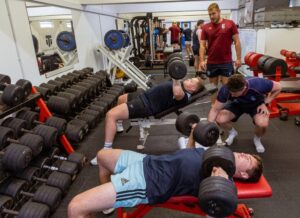There is no hiding from the fact that rugby is a dangerous sport. Injury prevention should be at the forefront of any player or coaches mind. Just check out the key findings of the RFU’s recent injury surveillance report:
- The incidence of match injuries in the Premiership was lower in 2015-16 than reported in any previous season. Data collection during the 2016-17 season will help clarify whether this is the start of a trend towards a lower overall injury incidence or an atypical year.
- The average time taken to return to play following a match injury in the 2015-16 season was 29 days, which falls within the expected limits of variation.
- Concussion for the fifth consecutive season was the most commonly reported Premiership Rugby match injury constituting appropriately 25% of all match injuries. It is the consensus view that the continued focus on improving concussion awareness and promoting behavioural change, the formal independent post-match video review of all head injury events as well as a more inclusive and specific identification criteria within the Head Injury Assessment (HIA) process have all contributed to this continued rise in concussion incidents.
- The mean severity of reported match concussions was 13 days. Compliance with mandatory return to play protocols after concussion were fully adhered to.
- The risk of all other (non-concussion) match contact injuries in the Premiership has not increased, suggesting that changes to the nature of the professional game are unlikely to be factors underpinning this increase in concussion incidence. Concussion prevention remains a priority for the game at all levels.
- 45% of all match injuries were sustained in the tackle. Concussion now comprises 20% of all injuries to the ball carrier and 47% of all injuries to the tackler
- The profile of the five most common and highest-risk match injuries has remained similar throughout the study period with the exception of concussion. As a result of its significant increase in incidence, concussion is now both the most common and highest risk match injury.
- The incidence of training injuries fell for the second consecutive season, but the average severity remained high at 30 days. The overall risk of training injury decreased for the third consecutive year, as a consequence of the fall in incidence. 40% of all injuries were sustained during training.
- There were again no clear differences in the incidence, severity or overall injury burden of time-loss injuries between matches played on artificial turf and natural grass.
- 10 players retired as a result of injury and one retired as a result of illness last season.
- There has been an increase in the incidence of match injuries in the England Senior side last season compared to the previous season. With a greater number of games played in a World Cup year, more match injuries were reported but the average severity of match injuries decreased. With this increased incidence but decreased average severity, the overall risk of match injury was seen to remain relatively stable.
It is clear to see that injury prevention needs to be addressed in your training program. And it’s not that bold a statement to say that rehabbing an injury is likely for you at some point in your playing career. Rehab is extremely important as the risk of re-injury is so high if you don’t do things right.
Thats why we developed the Rugby Proof Series which we have compiled into a user friendly ebook which gives you everything you need to rehab an existing injury and prevent further injuries. From general approaches to specific joint and common injury programmes Rugby Proof has it all. It really is the ultimate injury prevention program for rugby.




